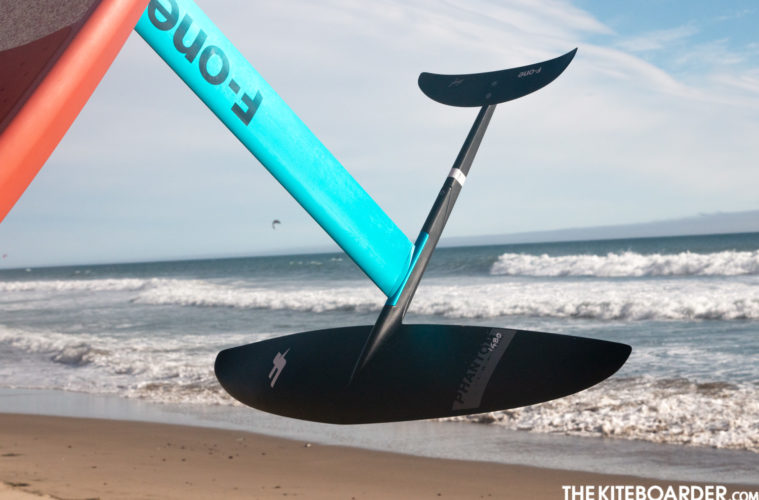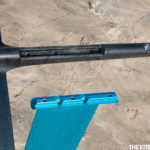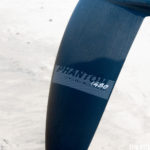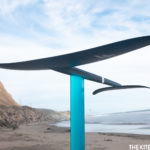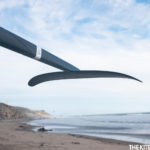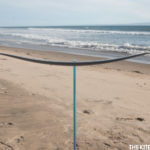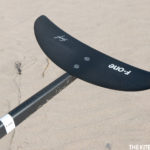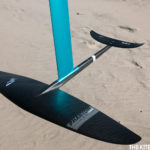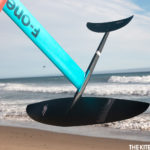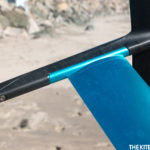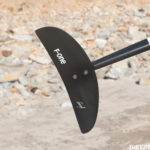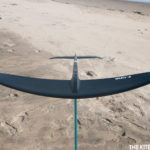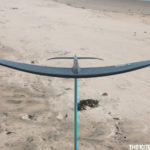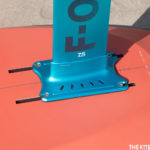F-ONE Phantom
Sizes Available: 1280cm2, 1480cm2, 1780cm2
Sizes Tested: 1480cm2 front wing with C275 Surf Stabilizer
F-ONE Says:
Using a refined design to achieve higher finesse, the Phantom foils glide faster and for longer. Connecting waves whether during surfing or downwinding thereby becomes much easier and more fun. Yet, connecting waves isn’t much fun if you can’t turn and this is why carving is also part of the DNA of the Phantom foils. By working on the lift distribution, arch shape and other details we achieved a high-aspect, performance foil that can carve smooth curves on the waves and swells.
Built using the Monobloc construction with pre-preg carbon, the foils are both very light and really strong. This set-up offers better load transmission and better stiffness throughout the different parts for maximum control. The Titan connection allows to plug both an aluminium or carbon mast and the fuselage is split in two parts to facilitate transportation.
The Phantom wings are recommended with the C275 Surf stab. This stabilizer offers better glide and a looser feel. It’s the ideal match for the speed and glide of the Phantom wings. The looser feel will help turning these higher aspect wings and provide an awesome surfing experience.
Visit for more info: www.f-one.world/product/phantom-carbon-1480/
Tkb Says:
F-One has released the Phantom line of full carbon foils that feature a higher aspect ratio and wider wingspan that takes aim at providing super stable turning and extra glide that allows you to stay locked into swell on downwinders and amplify your pump game.
The Phantom uses the same construction and mounting system as the F-One Gravity line of foils. The front wing and stabilizer are mounted on a robust two-piece carbon fuselage that breaks down for easy travel. The connection between the mast and fuselage has a complex keyed interface that seems to lock the mast and fuse together for stiffness. We tested the Phantom 1480 front wing and C275 Surf stabilizer wing, along with the 75cm aluminum mast that featured the new baseplate with the cutout mounting eyelets that allow for easier mounting. You can loosen the hardware just enough to slip the mast plate off the board and keep your hardware intact in the board. The F-One mounting uses the same size torque screw, but the hardware is a little bit smaller.
 Much like the Gravity, we were really impressed with the overall light weight of the wing and mast combo, particularly because the aluminum mast is not the lightest option you can get from F-One. The setup feels incredibly crisp yet still fairly light for easy handling on the beach and getting out through waves.
Much like the Gravity, we were really impressed with the overall light weight of the wing and mast combo, particularly because the aluminum mast is not the lightest option you can get from F-One. The setup feels incredibly crisp yet still fairly light for easy handling on the beach and getting out through waves.
In the water the first thing we noticed is the nice and slow foil-up speed. The Phantom has a little bit more of an aggressive departure angle when you hit its initial foil-up speed, but as you accelerate it evens out. The early lift isn’t aggressive, but you can feel the wing lifting at a higher angle of attack until it finds its sweet spot and then feels super smooth and stable. You can feel right off the bat the extra stability you get from the wider wingspan, particularly in the roll axis. When compared to the Gravity line of foils, the Phantom feels a bit more stable on the pitch and yaw axes, but much more noticeably on the roll axis. It’s worth noting this is the first year F-One has offered the C275 Surf stabilizer which makes the yaw axis much more maneuverable compared to the C300 with its large vertical winglets.
 If you’re trying to initiate aggressive carving, you will find that the Phantom likes big sweeping carves compared to the Gravity’s tight, nimble turning, but with a bit more input into the Phantom you can still have a lot of fun carving clean turns, you just have to use more heel/toe pressure to counteract the stability of the wider span.
If you’re trying to initiate aggressive carving, you will find that the Phantom likes big sweeping carves compared to the Gravity’s tight, nimble turning, but with a bit more input into the Phantom you can still have a lot of fun carving clean turns, you just have to use more heel/toe pressure to counteract the stability of the wider span.
The Phantom wing generates a fair amount of lift and doesn’t feel quite as fast as the Gravity, but seems to create more drive when you pump the board. Because the Phantom feels like it creates a bit of extra lift you can feel a little more acceleration when you tap into a lump of swell, which makes it a really fun wing for downwinders where you’re trying to tap every piece of swell energy available. When it comes to speed and carving up bigger chunks of energy, the wing’s stability across the roll, yaw and pitch axes gives you a little bit extra confidence to keep the wing under control at high speeds. Like many higher-aspect wings, you continue to get a lot of lift out of the wing clear into the top-end which means you will want to stay focused on keeping the wing buried in the water when you hit higher speeds. The 75cm mast seemed to work fine for us, but for those that like to carve harder turns, you might choose a longer mast option to keep the wingtip buried for super aggressive carving.
 The Phantom seems like a great option for wingsurfers who are looking for a little more low-end foil-up speed and some extra stability when up and riding. We’d also choose the Phantom for prone and SUP foilsurfing, specifically for the purpose of bumping up our pump game to get back to the top of the reef. The Phantom creates a ton of drive on pumps that help you stay on foil while looking for the next wave or swell to lock into. For wingsurfers, it’s the same game and the Phantom helps you find that energy and creates drive that will help you stay in the glide zone longer. Overall, the Phantom is a very important and timely addition to the F-One lineup with its super drivey and stable ride matched with lightweight but stiff appendages that deliver the perfect high-performance user experience.
The Phantom seems like a great option for wingsurfers who are looking for a little more low-end foil-up speed and some extra stability when up and riding. We’d also choose the Phantom for prone and SUP foilsurfing, specifically for the purpose of bumping up our pump game to get back to the top of the reef. The Phantom creates a ton of drive on pumps that help you stay on foil while looking for the next wave or swell to lock into. For wingsurfers, it’s the same game and the Phantom helps you find that energy and creates drive that will help you stay in the glide zone longer. Overall, the Phantom is a very important and timely addition to the F-One lineup with its super drivey and stable ride matched with lightweight but stiff appendages that deliver the perfect high-performance user experience.
Want to view all our 2020 Freeride, Light Wind and Wingsurf Gear Reviews in one convenient digital guide? If you’re already a subscriber, thank you for your support! Log into your account to view our 2020 Freeride Gear Review Guide. If not, click here to purchase a digital copy.


